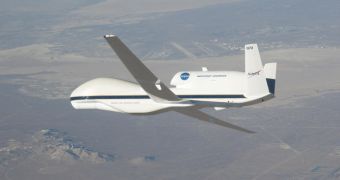Officials with Northrop Grumman announce that the American space agency will be using the Global Hawk unmanned aerial vehicle (UAV) next year, as part of the multi-year Hurricane and Severe Storm Sentinel (HS3) survey.
The purpose of the program is to study how hurricanes and other types of tropical storms form over the Atlantic Ocean. Experts also seek to understand the mechanisms that lead to changes in storm intensity as the weather fronts are moving north.
NASA has issued an order for the Global Hawk a couple of years ago, and the machine was delivered in 2010. It successfully flew a number of verification tests, and is now stored and ready to use at the NASA Dryden Flight Research Facility, which is located within the Edwards Air Force Base (EAFB).
The aircraft has tremendous range and autonomy, which is precisely what made it so appealing to NASA in the first place. It can also carry just as much equipment as any other research aircraft, and can conduct studies autonomously from altitudes exceeding 65,000 feet (19,800 meters).
“The high-altitude and long-duration capabilities of NASA's Global Hawks allow HS3 to sample storms virtually anywhere in the Atlantic and for durations up to three times that of conventional aircraft,” Scott Braun reveals.
“Being able to stay over a storm for 15 or more hours allows us to observe storms in ways that were simply not possible before,” adds the expert, the principal investigator of the study. He is based at the NASA Goddard Space Flight Center (GSFC), in Greenbelt, Maryland.
“Global Hawk's ability to fly as high as 65,000 feet for periods of up to 30 hours provides the science community the opportunity to explore remote areas of the Earth's atmosphere,” Scott Winship adds.
The expert holds an appointment as the vice president of advanced concepts at Northrop Grumman Aerospace Systems. “Global Hawk's flexible and mature design allows for modifying the aircraft with varying scientific instruments for different types of science missions,” he adds.
There are currently three main instrument suites installed on the Global Hawk that will be included in HS3. The largest is the Airborne Vertical Atmospheric Profiling System (dropsonde), which is built and operated by the US National Oceanic and Atmospheric Administration (NOAA).
The other two are the Scanning High-Resolution Interferometer Sounder (S-HIS), built by the University of Wisconsin and the High Altitude Monolithic Microwave Integrated Circuit Sounding Radiometer (HAMSR).

 14 DAY TRIAL //
14 DAY TRIAL //